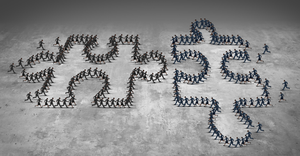New York Road Runners Help Set the Pace for Climate Action
Sports organizations and athletes are increasingly working to reduce their climate impact, with the New York Road Runners (NYRR) leading by example through initiatives like "Team for Climate," which aims to reach net zero by 2040. Launched in June 2024, this program focuses on reducing the organization’s carbon footprint, funding forestry projects for carbon offsets, and engaging runners as climate ambassadors.

As global temperatures rise, sports organizations and the athletes they exist for are working to reduce their impact on climate. New York Road Runners (NYRR) is a prime example. The nonprofit has long committed to sustainability to promote healthy cities and neighborhoods and ultimately a healthy planet for running, including pledging to reach net zero by 2040.
But when Rob Simmelkjaer came on board as NYRR’s CEO in 2022, he asked, “Why can’t we move faster?”
“We began thinking of steps to accelerate our process to reach net zero. We ultimately landed on the concept of Team for Climate, a program featuring a race entry method designed to help Road Runners reduce their carbon footprint and meet their sustainability goals as an event and as an organization,” Simmelkjaer says.
Just launched in June 2024 and powered by 250 runners participating in three marquee races, Team for Climate is the first initiative of its kind among major marathons.
Participants raise money to help fund New York state-based forestry projects; in exchange the organization gets carbon offsets. But their work goes deeper, focusing on shrinking the nonprofit’s own footprint.
“While carbon offsets are part of our strategy to combat climate change and get to net zero, it’s not the only approach to get us get there. So, we are also investing in reducing our scope 1 emissions,” says Aly Criscuolo, New York Road Runners Sustainability and Corporate Social Responsibility director.
This November, Team for Climate runners’ marathon day will begin early as they file onto the Staten Island Ferry, a relaxing and cleaner alternative to firing up their car engines and driving over to the start area.
As they deboard, they will make their way to a solar-powered start tent to stretch, eat, and hydrate before heading out to the Staten Island Bridge to begin their 26.2-mile journey. They’ll be clad in running shirts with a message for the crowd of onlookers: the “singlets” are emblazoned with climate stripes that go from a cool blue to hot red, representing the heating of the earth, a symbol to raise awareness around a global problem calling for action.
“The most important thing these runners are doing is serving as ambassadors for us as we work to eliminate the carbon footprint of this event,” Simmelkjaer says.
They are driven. They run outside and need clean air and temperate temperatures to complete races. They are feeling the effects of climate change.
“Last summer we had smoke from city wildfires for a week and a half and had to cancel several events. And we have had to cancel group trainings and races because of extreme heat.
“There are fewer days where they are running under optimal conditions, and so they, I believe, are more attuned to climate and rising temperatures,” he says.
Days before the marathon, they will come out for a “plogging” event, donning gloves and carrying bags they will stuff with trash they pick up as they jog along the city streets to loosen up before their big run.
Their understanding of the value of clean air and green spaces is why the forestry carbon offset projects—one in New York State and one spanning New York and neighboring states—are so important. They will help preserve and replenish over 12,000 acres of plant- and wildlife-rich land.
“We love that these projects are in New York State and that people will be able to access the land to hike and run while enjoying nature,” Criscuolo says.
NYRR’s sustainability focus, beyond Team for Climate, leans heavily on diversion. Green team volunteers sort massive volumes of event waste from strategically placed stations– more than 500 tons of it are generated at the top three races alone—300 tons of which is diverted with help not just from volunteers but from city partners and vendors. Trash and recyclables are hauled by the New York City Department of Sanitation and a local company that further sort out contamination. Organics are processed at a farm upstate.
Homeless shelters across the five Burroughs receive and distribute extra clothing layers that runners show up in to stay warm then drop off in collection bins. T-shirts and other surplus race premiums go to organizations that support athletes in underserved communities. And a New York City food rescue charity picks up and distributes untouched leftover edibles to community members in need.
Minimizing waste on the front end lessens the load. It has meant cutting back on single-use food service ware; swapping out plastic cups for compostable ones; and smarter purchasing—Road Runners bulk buys bananas, water, and other nutrients that fuel the 105,000-plus participants in the top three annual events alone.
Collaboration with other players has been key to taking their work further. The organization partners with the National Basketball Association, The National Football League, the National Hockey League, and other sports operations with sustainability programs and is a member of multiple groups dedicated to helping sports organizations collectively advance initiatives to reverse earth’s warming.
Global temperatures continue to rise, with 2023 noted as the hottest year on record, according to the National Oceanic and Atmospheric Administration. And three-quarters of athletes have been directly impacted by this trend, a survey by World Athletics found.
Average temperatures during the 2024 Paris Games were 5.5 degrees higher than 1924, the year of the first Olympics Games, according to a report written by U.S. nonprofit Climate Central and co-authors.
During a women’s steeplechase race at the Tokyo Olympics in 2021, stadium temperatures spiked to 100.4 degrees. That same year, temperatures hit a blistering 110 degrees at the U.S. Olympic track and field trials.
Winter sports are feeling the pain, too. In 2022/2023, seven of the first eight scheduled Alpine Ski World Cup Season races were cancelled due to marginal climate conditions.
Other events are increasingly rescheduled due to extreme weather. And these impacts are felt by all athletes, from little league teams and other community clubs to professionals.
More sporting organizations are leveraging their influence to help drive change, as are individual celebrities such as former track and road cyclist Chris Boardman and Cricket World Cup winner Tammy Beaumont who have spoken up on the connection between climate change and sport and potential long-term impacts.
The United Nations is working to mobilize athletes around the globe through its Sports for Climate Action initiative, providing sports organizations a forum to share what has worked, lessons learned, and to develop new approaches to decarbonize the world. Signatories are asked to commit to halving their emissions by 2030 and to reach for net zero by 2040.
Sports for Climate Action is one of the programs NYRR is part of. Says Criscuolo, “The best part about sustainability in sport is the community. We all have a goal of combating climate change and making the industry more sustainable. So, we and our peers are all are conversing and sharing best practices.”
Together these organizations aim to take the message further and set the stage to advance progress.
About the Author
You May Also Like




.png?width=300&auto=webp&quality=80&disable=upscale)